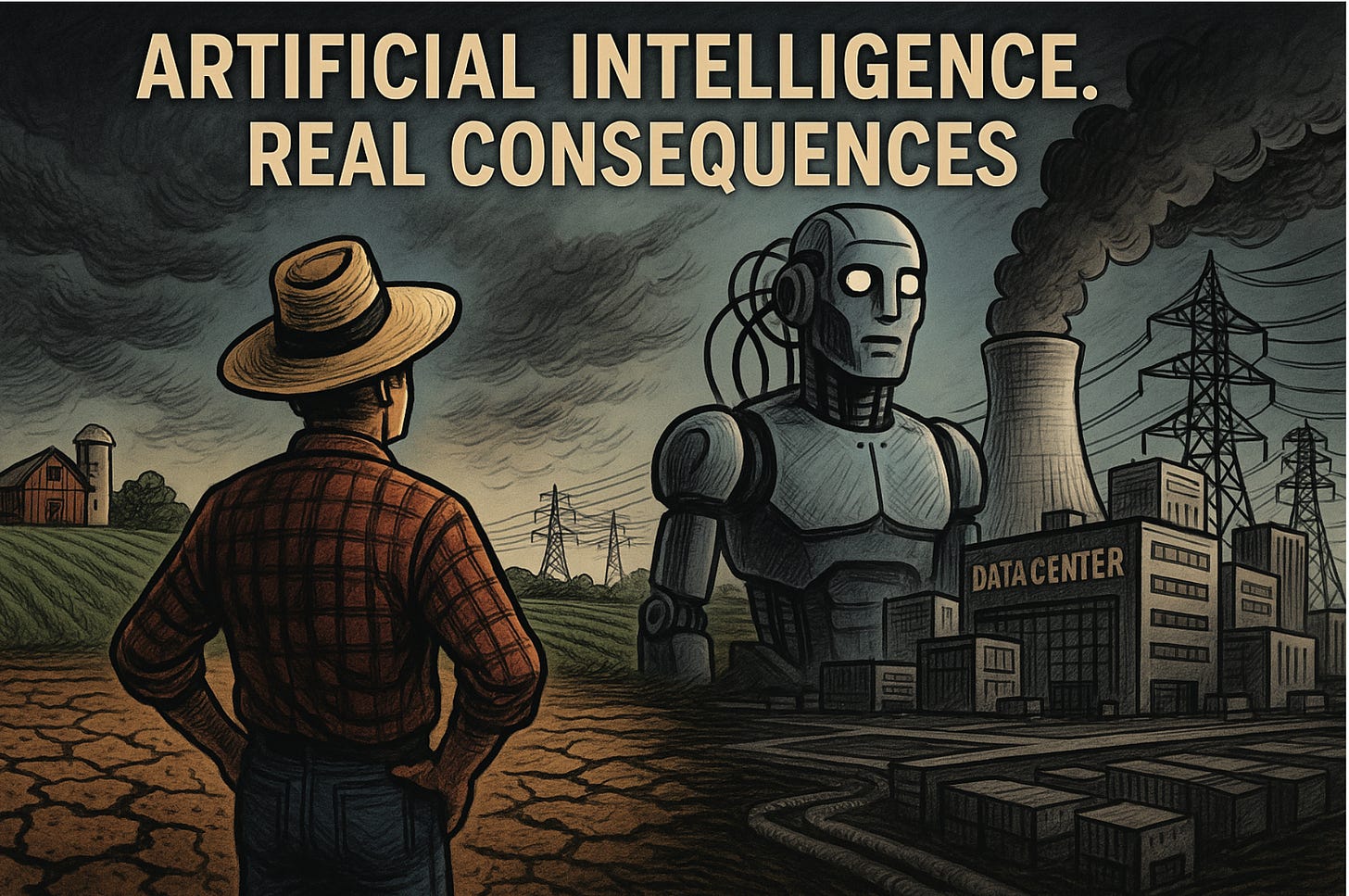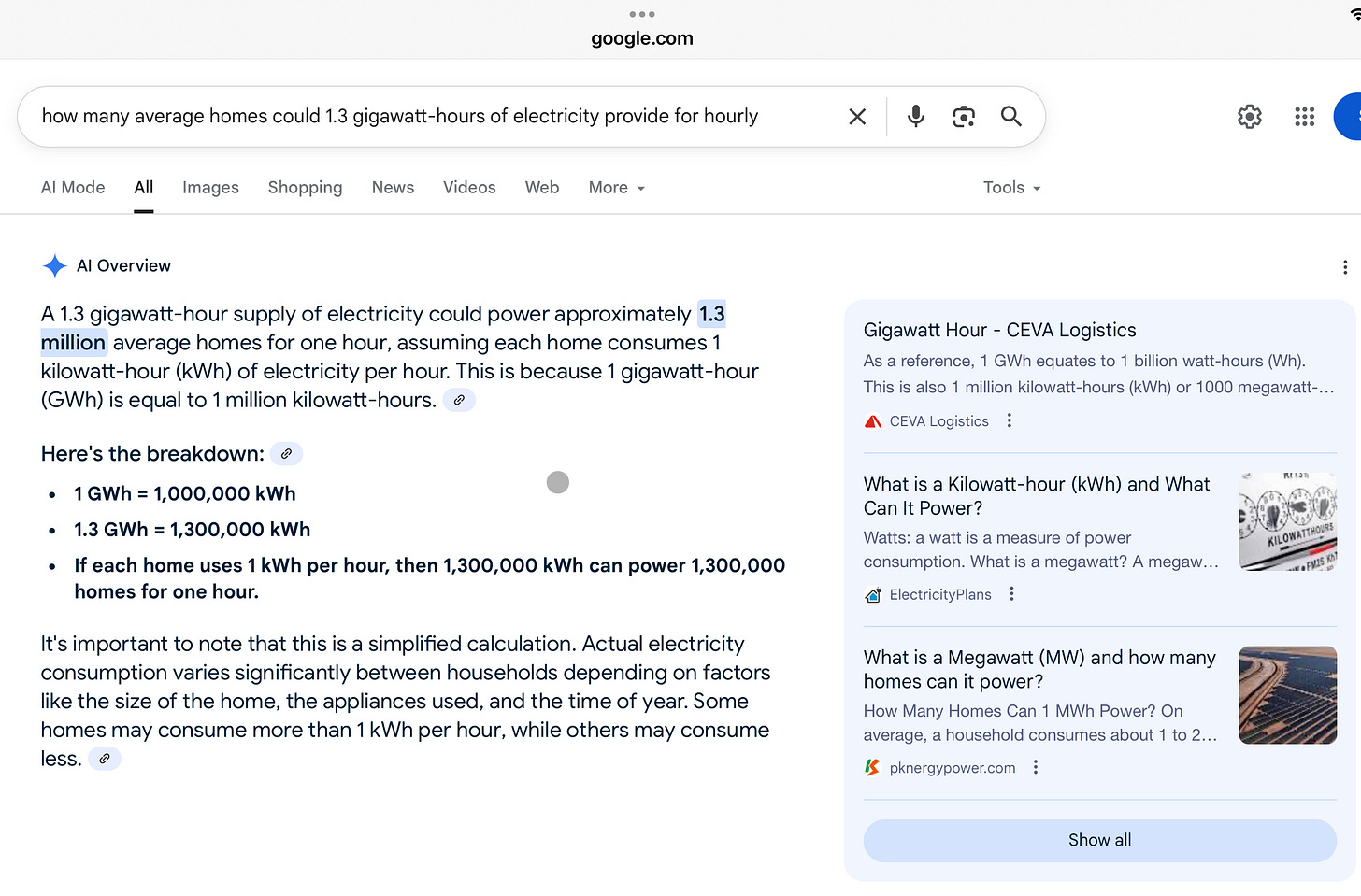You Can’t Drink Data
AI Doesn’t Farm, Feed, or Care
I recently reshared a post from my friend Jeff Pierson after a town hall in Jerome Idaho about a new nuclear energy project. His summary made one thing clear: the presentation by Sawtooth Energy and Development Contractor was full of polished talk but short on answers. The message was simple “trust the process.”
That got me thinking.
AI (artificial intelligence) demands massive amounts of energy. Nuclear power is being pitched as the answer but reactors need enormous quantities of water. So do data centers, chip factories, which are all part of this tech expansion.
Meanwhile, our farmers are already struggling for water. Our aquifer is strained, and now even more pressure is being added.
Here’s the reality: we don’t need AI to survive. Humanity lived without it for thousands of years, and America prospered for over 250 without it. Before we charge into a future built on high-tech promises, we need to ask what are we sacrificing, and why?
To be clear, I’m not against nuclear energy. And I’m not against technology either. But our water supply is already under serious stress. Every new project whether it’s a reactor, data center, or factory draws even more from that limited supply.
Do we really have enough water to keep up with these demands? Or is it time to stop and protect what we have before it’s gone?
Before continuing, click the link below to listen to the town hall and read Jeff’s post. Both are hosted on Facebook, so if you don’t have a Facebook account, you may not be able to access them. Jeff Pierson Post , Jerome Town Hall Live Feed .
How Much Energy Does AI Really Use?
Here in Idaho, we understand the importance of reliable energy whether it's keeping our homes warm in the winter, running irrigation on our farms, or powering local businesses. But now, there’s a new and growing demand on our grid: artificial intelligence.
When I visited the Idaho National Laboratory, they told us something that stuck with me, “it takes as much energy to run AI as it does to power a small city”.
Let’s think about that.
Training just one large AI model (like the ones behind ChatGPT or image generators) uses around 1.3 gigawatt-hours of electricity. That’s enough power to provide electricity for 1.3 million average homes for one hour, assuming each home consumes 1 kilowatt-hour (kWh) of electricity per hour.
These models operate 24/7 in massive data centers that require a steady, uninterrupted flow of electricity constantly.
So while AI might feel like a neat tech tool or a distant innovation, it’s already placing real pressure on our energy supply right here in Idaho.
How Much Water Will Nuclear Energy and AI Need?
In Twin Falls, the city recently approved a request from Chobani to draw an additional 1 million gallons of water per day on top of what they already use. To put that in perspective, 1 million gallons a day is enough to supply water to over 300 Idaho households with their daily needs. Now stack that on top of future nuclear reactors and AI infrastructure, and we’ve got a serious challenge on our hands.
Nuclear reactors used to power energy-hungry AI systems typically require up to 1 million gallons of water daily per reactor for cooling alone. And that’s just one piece of the puzzle.
AI data centers, like those run by Google and Microsoft, also demand enormous water supplies to keep servers from overheating. One facility in Oregon used over 360 million gallons of water in a single year enough to irrigate thousands of acres of Idaho farmland during a growing season. Link
A High-Priced Gamble Without a Blueprint.
Sawtooth Energy and Development, based right here in the Magic Valley, is run by Roy Prescott a name many locals recognize from his family’s long history in cattle ranching on public lands. Now, the company is stepping into the nuclear energy world, proposing a 462-megawatt small modular reactor just outside Jerome. The proposed site sits near the Lava Ridge wind farm footprint and would use the Idaho Power substation originally designated for that wind project. (Here is the LINK that tells you the website is private)
Project manager Dan Adamson recently told KMVT in Twin Falls that the reactor project will cost around $7.5 billion, funded through federal grants, tax credits, and third-party financing. But that estimate seems inflated. Based on NuScale’s current $6,500-per-kilowatt model, the total should be closer to $3.08 billion nearly half of what Adamson projected. Even more troubling, he offered no estimate for what electricity would cost if the project did hit the $7.5 billion mark. At a recent public meeting, both Prescott and Adamson struggled to answer basic questions about water use, safety protocols, and long-term nuclear waste storage. To top it off, Idaho Power confirmed it has not received any request from the firm to connect the project to the local grid or the nearby substation. Read link HERE
A little history here back in 2018, when I ran for the Idaho House of Representatives, Roy Prescott was one of my challengers. It became a three-way race that handed the win to Laurie Lickley. Just imagine if Roy had won, these massive energy projects would likely already be in motion, pushed forward despite resistance from neighbors, farmers, and the city itself.
The AI Action Plan and the Power Behind It
On January 23, 2025, President Trump signed Executive Order 14179, known as the AI Action Plan. The goal was clear: make America the global leader in artificial intelligence by removing regulatory roadblocks, fast-tracking innovation, and rolling back federal overreach especially in areas like speech censorship and ideological bias.
But behind the headlines and high-tech talk lies a very real, very practical issue:
AI needs power. And a lot of it.
That’s where the connection to energy infrastructure becomes unavoidable.
While the AI executive order didn’t directly rewrite energy policy, it lit a fire under it. With the growing demands of AI particularly from massive data centers the federal government needed a scalable, reliable, and long-term solution. That’s why, just months later, Trump signed a second set of executive orders in May 2025 to fast-track nuclear energy development.
The message was clear: If AI is the future, nuclear is the fuel.
What Are We Willing to Sacrifice for AI?
We’re being told to “trust the process.” That nuclear energy, billion-dollar tech, and water-hungry data centers are just the price of progress.
But progress toward what? And at what cost?
Every new reactor, data center, micro-chip factory, and industrial project pulls more from our already strained aquifer and from the energy resources that power our state that feed our farms and sustain our way of life.
All to power artificial intelligence?
Let’s be honest we don’t need AI to survive. We’ve done just fine without it for thousands of years. But we do need water. We do need farmland.
So before we sacrifice what truly matters, we need to ask:
Is the promise of AI worth the price of our land, our water, and our freedom?
Once we give up our resources they’re gone. And AI won’t save us when the well runs dry.
“…so that no one can buy or sell unless he has the mark…” Revelation 13:17 (ESV)
Revelation warns of a seductive global system rich, powerful, and convincing, but built on deception, control, and moral collapse. We must not blindly invest in the very systems that could one day own us, monitor us, and ultimately strip us of our freedoms.
Idaho has a choice. America has a choice. WE have a choice.
What will that choice be?
Bible Verse: Matthew 7:24-27
24 “Everyone then who hears these words of mine and does them will be like a wise man who built his house on the rock. 25 And the rain fell, and the floods came, and the winds blew and beat on that house, but it did not fall, because it had been founded on the rock.26 And everyone who hears these words of mine and does not do them will be like a foolish man who built his house on the sand.27 And the rain fell, and the floods came, and the winds blew and beat against that house, and it fell, and great was the fall of it.”
Quote: Revenge, lust, ambition, pride, and self-will are too often exalted as the gods of man's idolatry; while holiness, peace, contentment, and humility are viewed as unworthy of a serious thought. Charles Spurgeon
Song:




I went to Naval Nuclear Power training outside of Idaho Falls in the 70's. I then served as a Reactor Operator for the Navy for the next 3.5 years. Reactors do use water for cooling, but the water is not consumed. There may very well be arguments against commercial Nuclear produced electricity, especially in regards to the cost to the end consumer, but the water argument seems manageable. Please stay on top of this issue. Power through grants seems a bit dubious on it's face.
I do not believe Nuclear is what Idaho needs. I lived in Oregon and Nevada! Oregon had Nuclear reactor on the Columbia, and again the rods had to have tons of cool water on them to keep them from blowing up, let alone talk about the radiation and how it pollutes everything! The fish in the Columbia have developed extra eyes and fins; not good since we eat the fish! Nevada took in other states nuclear waste, and put it in the ground above the aquafer in Pahrump, so all the waste could pollute the water and ground! For a dollar!
I believe it's the country of Sweden that has a large plant that powers electricity and heat for people and it burns human waste. That is a good way to get rid of waste and give people employment. NO smell and gets rid of polluting stuff! I would be happier to see the waste burning plant in Jerome instead of Nuclear!